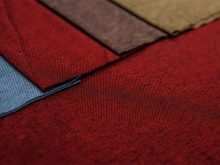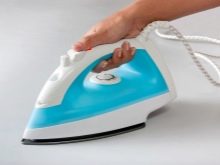All about lacoste

Lacoste fabric is widely used in the manufacture of sportswear. The loose structure of the fabric allows the skin to breathe, which is considered one of the main advantages of the material.


What is this material?
According to the description of the material, lacoste is a fabric with a special weave of fibers. Cotton is most often used to create it, although options are possible based on wool, bamboo, synthetic threads (viscose and elastane) and even boiled corn. The latter is obtained by bringing dextrose to the state of lactic acid, as a result of which threads are formed. The main similarity between these options lies in the choice of a particularly strong and rather complex combined weave, using two warp and weft threads. Small loops are superimposed on each other, forming something like a honeycomb, which ensures the porosity and looseness of the fabric.
The resulting knitwear also acquires a relief surface covered with well-visible geometric patterns: rhombuses, ribs or squares. Patterns are noticeable only on the front side, and the wrong side is often covered with pile when they are deprived of them. In fact, lacoste is the same as piqué fabric, whose name from French even translates as "quilted". In the manufacture of the material, natural or mixed raw materials are thoroughly cleaned, after which they are loaded into a knitting machine. The device mechanically provides a complex weave by overlapping the threads at a certain angle. At the end of the stage, the fabric is tinted in the desired shade and dried.



Properties
Speaking about the features of the fabric, it is worth mentioning both the pros and cons. Let's start with the positives.
- The main advantages of lacoste fabric are called its lightness and high hygiene. It is comfortable to wear quilted knitwear even in hot weather or under intense loads, so it is not surprising that the material is often chosen for sewing sportswear. Wearing such clothes in the summer, a person will not experience the effect of a steam room. Soft and pleasant to the touch, the lacoste is not only breathable, but also quite durable. It follows the contours of the body without restricting movement. The material is highly breathable and absorbs moisture.
- The canvas does not wrinkle and, even with constant use, does not lose its original shape. After numerous washes, even in the usual mode, no pellets form on the clothes.
- Mention should be made of the hypoallergenicity of knitwear. The composition of the fabric is very good, since any variety contains at least 50% of natural cotton, and synthetic impurities are added in an amount of no more than 2%.
Lacoste's wide color palette allows it to be used for different purposes. However, the canvases are almost always painted in the same color and it is often not customary to apply images or prints on them.



There are few cons, but they should also be taken into account.
- The disadvantage of the material is that it does not stretch well, especially when it comes to the classic version. In addition, the denser the product is, the less elastic it shows. Varieties containing synthetic fibers stretch better.
- The surface of the knitted fabric is susceptible to ultraviolet radiation, and products made from it are prone to shrinkage.



Views
Lacoste knitwear may differ depending on the composition: whether it contains only vegetable raw materials or also threads of animal and synthetic origin. The pattern of the interlacing of threads is also different: in the form of hexagons, squares and figures with eight faces.
In addition, it is customary to distinguish several types of canvases.
- Children's knitwear is a soft high-density cotton fabric with small villi on the seamy side.
- Plain jersey is the most common. It is also crafted from pure cotton for sportswear.
- The third variety, called bumazey, is a modified children's knitwear. It has a denser fleece on the seamy side and is suitable for creating jackets, jackets and demi-season clothing.
- The coarse-mesh pique can also be distinguished separately., which is the basis for waffle towels. The material can be stiffer or softer and exhibit large cells or small honeycombs.



What is sewn from fabric?
The material called lacoste is easy to work with, and quite practical, and therefore, in theory, it is suitable for sewing almost any thing. Initially, this jersey was used exclusively for the creation of tracksuits. Today, the scope of its application has become much broader. So, pique is suitable for creating such casual clothes as summer dresses and sundresses, turtlenecks, blouses and shirts, T-shirts, skirts and shorts. The fabric makes excellent children's clothing - comfortable, hypoallergenic and characterized by a long service life.
The material is also suitable for the manufacture of hats, decorative items of clothing, sports swimwear and home textiles. It is necessary to clarify that kitchen towels and bed linen are created from a denser pique, and varieties with the maximum content of natural ingredients are selected for children's clothing. Expandable lacoste is more suitable for swimsuits and shorts.



How to choose?
To purchase a quality lacoste, you need to carefully study the information provided on the packaging. The composition must contain at least 50% natural cotton and no more than 2% synthetic impurities. A large amount of synthetics can cause the item to stretch over time.The amount of cotton over 50% is a guarantee that the product will be softer, more breathable and absorbent, but it will be worse to keep its shape. The addition of nylon will increase the strength of the product and increase the durability, but the clothes will become coarser. Interspersed with woolen fibers makes the fabric warmer.
Attention should also be paid to the appearance of the canvas itself: it should not show distortions or asymmetry of the ornaments. In addition, the cut should not stretch well. In general, when shopping, it is important to understand the difference between lacoste knitwear and piqué items sold under the Lacoste brand. The price of a branded product will be much higher, however, the quality of the product will be much better.
Lacoste products are most often counterfeited, and therefore, even purchasing clothes with the famous emblem in the form of a crocodile, you can become the owner of a low-quality product.


How to care?
You need to take care of lacoste fabric products in a certain way.
- Piqué cannot be washed with other materials, the same prohibition is relevant for washing clothes of different shades.
- The optimum temperature for water treatment of the product does not go beyond 30-40 degrees, and the washing time should be an hour and a half. This rule applies to both manual and machine processing.
- When choosing a program in an automatic device, you should give preference to the most gentle mode. It is not allowed to bleach lacoste. Moreover, only mild detergents are suitable for canvases, which do not contain chlorine and other aggressive components.
- It is recommended to wring out clothes no more than 10 minutes at minimum speed. Ideally, things are not squeezed out at all: the water is allowed to drain, after which they are sent to dry on a horizontal surface or directly on hangers. It is important that at this moment direct sunlight does not fall on the fabric.
- Ironing of pique products is carried out only from the seamy side, although this is not at all necessary. Things should not be steamed, in addition, during heat treatment, the temperature should not be raised above 110 degrees. It is more correct to focus on the hot processing parameters indicated on the label, or on the "synthetics" mode.
- Lacoste should be stored either on hangers or on shelves in a space with good ventilation, lack of sunlight and low humidity. If the item is removed for long-term storage, then you should additionally use a cover. In case of serious contamination, it is better to take the product to dry cleaning.
- It is not forbidden to even lightly starch the fabric, which will give it a neater look.
It should also be added that the cuts purchased from the store must be soaked in warm water before cutting and sewing.











